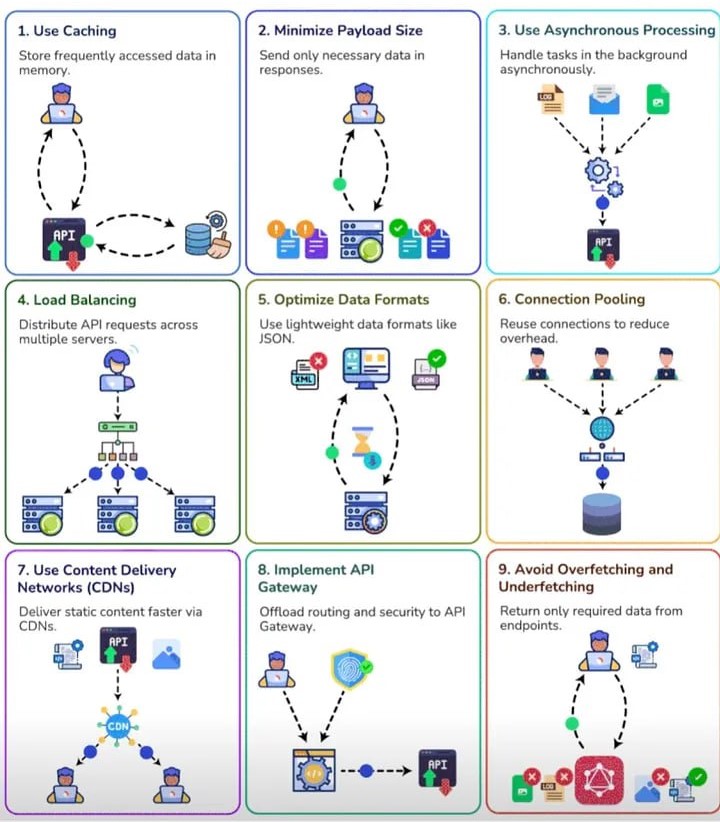Key Strategies to Boost API Performance in ASP.net

Introduction
APIs are the backbone of modern ASP.NET applications, facilitating seamless communication between frontend and backend systems. However, slow APIs can lead to poor user experience, high latency, and system bottlenecks. To ensure optimal performance, ASP.NET developers must implement the right strategies.
In this blog, we’ll explore key techniques to enhance API performance and improve overall efficiency in ASP.NET Core and ASP.NET Web API applications.
1. Optimize Database Queries
One of the major culprits behind slow APIs is inefficient database queries. To boost performance:
- Use proper indexing to speed up query retrieval.
Example
CREATE INDEX idx_ProductName ON Products(Name);
- Optimize SQL queries by reducing unnecessary joins and subqueries.
- Implement caching mechanisms to minimize database hits.
- Use denormalization where appropriate to reduce expensive joins.
2. Implement Caching
Caching is a powerful way to reduce API response times. Strategies include:
- Server-side caching for frequently accessed data.
Example of response caching
app.UseResponseCaching();
[HttpGet]
[ResponseCache(Duration = 60, Location = ResponseCacheLocation.Client)]
public IActionResult GetCachedData()
{
return Ok(new { Data = “Cached Response”, Timestamp = DateTime.UtcNow });
}
- Client-side caching to reduce redundant API calls.
- Edge caching using CDN services to serve responses faster.
3. Reduce Payload Size
Large payloads increase response times and bandwidth usage. To optimize:
- Use gzip compression to reduce response sizes.
Example
Install-Package Microsoft.AspNetCore.ResponseCompression
- Remove unnecessary data fields from API responses.
- Implement pagination and filtering for large datasets.
4. Use Asynchronous Processing
Blocking API requests slow down performance. Instead:
- Implement asynchronous processing using background jobs.
- Use message queues for non-immediate tasks.
Employ WebSockets or server-sent events (SSE) for real-time updates
[HttpGet("{id}")]
public async Task GetProduct(int id)
{
var product = await _dbContext.Products.FindAsync(id);
return product != null ? Ok(product) : NotFound();
}
5. Optimize API Gateway and Load Balancing
An API gateway helps manage traffic efficiently. Best practices include:
- Use rate limiting to prevent API abuse.
Use Install-Package AspNetCoreRateLimit to rate limit
- Implement load balancing to distribute traffic across multiple servers.
- Optimize routing and request forwarding to minimize overhead.
6. Leverage Content Delivery Networks (CDN)
For APIs serving static or semi-static content:
- Use a CDN (Cloudflare, AWS CloudFront) to cache responses closer to users.
- Reduce server load and latency by offloading API responses to edge locations.
7. Monitor and Analyze API Performance
Continuous monitoring helps identify performance bottlenecks. Tools to use:
- APM tools for real-time API performance tracking.
- Logging and tracing to diagnose slow requests.
- Synthetic API testing to simulate user behavior and detect issues early.
8. Optimize Authentication and Security Measures
Security can impact API speed. Improve it by:
- Using lightweight authentication mechanisms like JWT instead of OAuth for non-critical endpoints.
- Implementing token caching to reduce redundant authentication calls.
- Optimizing encryption algorithms for secure but efficient communication.
9. Upgrade to HTTP/2 or gRPC
API performance can benefit from protocol improvements:
- HTTP/2 allows multiplexing and reduces latency.
webBuilder.ConfigureKestrel(options =>
{
options.ListenAnyIP(5001, listenOptions =>
{
listenOptions.Protocols = HttpProtocols.Http2;
});
});
- gRPC (Google Remote Procedure Call) provides faster communication with binary serialization.
10. Conduct Regular Performance Testing
Proactive testing ensures APIs remain efficient under different conditions:
- Use load testing tools like JMeter.
- Perform stress testing to evaluate API scalability.
- Identify and eliminate bottlenecks through profiling and benchmarking.
Conclusion
Boosting API performance requires a combination of database optimization, caching, load balancing, monitoring, and efficient protocols. By implementing these strategies, developers can ensure that their APIs remain fast, scalable, and reliable—delivering a seamless experience to users and applications.
By integrating these best practices, you can enhance API speed, reduce latency, and optimize resource utilization. Start implementing them today to take your API performance to the next level!
Recommended Posts

Building Secure APIs: Best Practices Every Developer Should Follow
February 18, 2025



